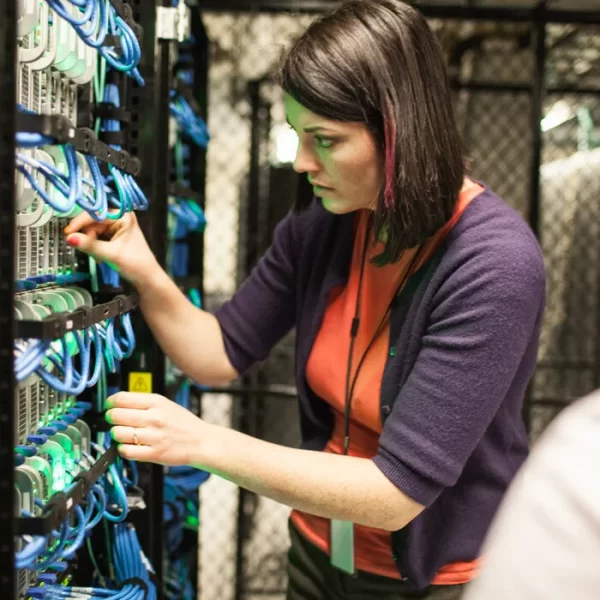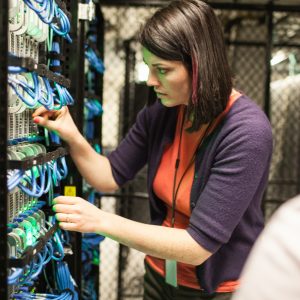Course Description:
This two-day training course is for operators and administrators who create and manage virtual machines. This course provides you with an understanding of VMware virtual machine features in VMware vSphere® 6.7. By combining lecture and hands-on labs, you gain the skills required to work effectively with VMware virtual machines.
Course Objectives
By the end of the course, you should be able to meet the following objectives:
- Describe virtualization, virtual machines, and vSphere components
- Describe the concepts of server, network, storage, and desktop virtualization
- Deploy, configure, clone, and manage virtual machines
- Use VMware vCenter Server® to monitor virtual machine resource usage
- Use VMware vSphere®vMotion® and VMware vSphere® Storage vMotion®to migrate virtual machines
- Use VMware vSphere® Distributed Resource Scheduler™ and VMware vSphere® High Availability to optimize the performance of your vSphere virtual environment
Course Modules
Course Introduction
- Introductions and course logistics
- Course objectives
Introduction to vSphere and the Software-Defined Data Center
- Describe how vSphere fits into the software-defined data center and the cloud infrastructure
- Explain how vSphere interacts with CPUs, memory, networks, and storage
- Use vSphere Client to access and manage your vCenter Server system and ESXi host
- Compare virtual machine hardware version 14 to other versions
- Identify the virtual network adapters, and describe the enhanced VMXNET3
- Compare the types of virtual disk provisioning
Creating Virtual Machines
- Create, provision, and remove a virtual machine
- Explain the importance of VMware Tools™
- Describe how
vCenter Server
- Describe the vCenter Server architecture
- Discuss how ESXi hosts communicate with vCenter Server
- Use vSphere Client to manage the vCenter Server inventory
- Add data center and organizational objects to vCenter Server
- Add hosts to vCenter Server
- Discuss how to create custom inventory tags for inventory objects
- Monitor VMware vCenter® Server ApplianceTM
- Monitor vCenter Server Appliance for service and disk space usage
- Use vSphere alarms for resource exhaustion and service failures
Configuring and Managing Virtual Networks
- Describe the virtual switch connection types
- Configure and view standard switch configurations, such as virtual machine port group, VMkernel port, VLAN, and security features
- List the features comparison of standard and distributed switches
Virtual Storage
- Describe vSphere storage technologies and datastores
Virtual Machine Management
- Use templates and cloning to deploy new virtual machines
- Enable guest operating system customization by vCenter Server
- Upgrade a virtual machine’s hardware
- Perform an instant clone of a VM
- Describe virtual machine settings and options
- Add a hot-pluggable device
- Dynamically increase the size of a virtual disk
- Add a raw device mapping (RDM) to a virtual machine
- Perform a vSphere vMotion migration
- Perform a vSphere Storage vMotion migration
Resource Management and Monitoring
- Use the performance-tuning methodology and resource monitoring tools
- Use performance charts to view and improve performance
- Monitor the key factors that can affect the virtual machine’s performance: CPU, memory, disk, and network bandwidth use
- Create alarms with condition-based triggers
- View and acknowledge triggered alarms
vSphere HA
- Describe the options that you can configure to make your vSphere environment highly available
- Discuss the response of vSphere HA when an ESXi host, a virtual machine, or an application fails
vSphere DRS
- Describe the functions of a vSphere DRS cluster
- Create a vSphere DRS cluster
- View information about a vSphere DRS cluster
- Remove a host from a vSphere DRS cluster
Target Audience
Technical professionals with system administration skills and operators responsible for managing virtual machines using VMware ESXi™ and vCenter Server.
Prerequisites
This course has the following prerequisites:
- System administration experience on Microsoft, Linux, and Solaris
- Understanding of basic network and storage concepts
Inclusions
With CCS Learning Academy, you’ll receive:
- 2 Day Certified Instructor-led training
- Official Training Seminar Student Handbook
- Collaboration with classmates (not currently available for self-paced course)
- Real-world learning activities and scenarios
- Exam scheduling support*
- Enjoy job placement assistance for the first 12 months after course completion.
- This course is eligible for CCS Learning Academy’s Learn and Earn Program: get a tuition fee refund of up to 50% if you are placed in a job through CCS Global Tech’s Placement Division*
- Government and Private pricing available.*
*For more details call: 858-208-4141 or email: training@ccslearningacademy.com; sales@ccslearningacademy.com






